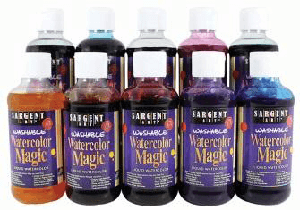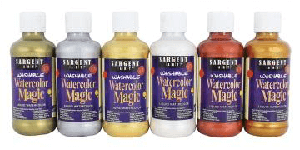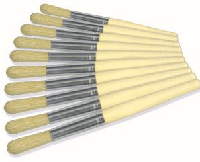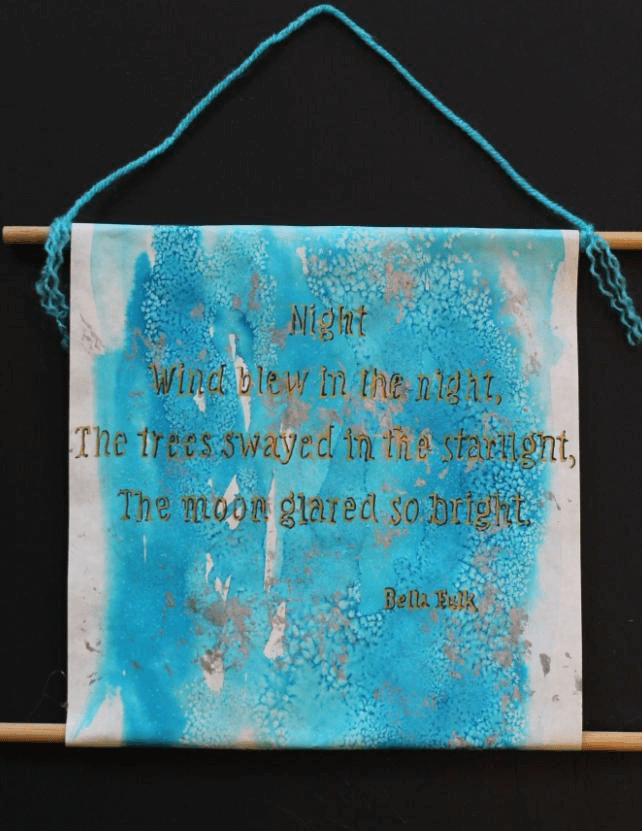6th grade student project using Sargent Art Liquid Watercolor (wet-on-wet w/ salt), Sargent Metalic Watercolor (texture added w/ plastic wrap), Gold Liquid Metals marker, Sharpie (extra fine), parchment paper, dowels & yarn.
Goal (Terminal Objective):
Students will write a Haiku poem, then create a scroll with a watercolor background. This unit is jointly planned with a Creative Writing (or ELA teacher).
Objective:
Students will explore several abstract watercolor techniques. They will study the Haiku form and write their own original Haiku.
National Visual Arts Standards:
Visual Arts Grades 5-8 Content Standard I: Understanding and applying media, techniques and processes.
Visual Arts Grades 5-8 Content Standard IV: Understanding the visual arts in relation to history and cultures.
Visual Arts Grades 5-8 Content Standard VI: Making connections between Visual Arts and other disciplines.
Purpose:
Students will practice several watercolor techniques. Students will view and examine important works of traditional Japanese art. Drawing from their own experiences with nature, they will write a Haiku. Students will create a scroll with their Haiku written on an abstract watercolor background.
Vocabulary:
Haiku, transparent watercolor, warm and cool colors, complementary colors, wet-on-wet technique
Materials:
Paper plate or plastic palette, student grade watercolor paper (or butcher paper or parchment paper), scrap paper for lettering practice, Viva or Bounty paper towels, masking tape, rubbing alcohol, Q- tips, salt, plastic wrap, small plastic containers w/ lids ( for watercolor, salt, alcohol), large plastic containers (for water), hole punch, yarn or DMC thread, ¼” diameter or smaller dowels (2 pieces per child), hair dryer

#22-6010 8oz. Washable Watercolor Magic 10 pcs.

#22-6097 8oz. Washable Metallic Watercolor Magic 6 pcs.

#56-1100 10ct. Jumbo Brush pk, plastic handle

#56-3015 GoldenTaklon brushes

#22-1506 Metallic Medium Point Peggable Carton
Time:
4 lessons (45 minutes each)
Resources
Asian Art- Michael Kerrigan; www.metmuseum.org (look for Art of the Edo Period)
Introduction and Motivation Set
Teacher introduces students to traditional haiku poetry and images of Japanese artwork. What kind of symbolism did the Japanese use that communicated their culture to the world? Students will discuss their most vivid memory of a single incident they experienced in nature. The teacher will discuss the history of Haiku poetry and demonstrate how to write a haiku. The teacher will demonstrate watercolor techniques and give the students guided practice in each.
Instruction
Lesson 1: Students will be introduced to a short history of and the formula for writing Japanese Haiku poetry. Following the reading of two Japanese haikus and a short PowerPoint (or show prints) of Japanese scroll paintings and pottery, students will write their own haiku. Collect these and save
Lesson 2: Paint can be dispensed in small plastic containers w/ lids or in palettes for students to share. Salt & alcohol can be dispensed to each group in small plastic containers w/ lids. Each student should have a paper towel (for clean-up) & a piece of plastic wrap. Teacher demonstrates watercolor techniques using Sargent Art Liquid Watercolor. Students use masking tape to divide practice paper into 4 sections. They should use wet-on-wet techniques on each section, right before adding alcohol or salt or plastic wrap.
- Wet-on-wet: Wet practice paper quickly w/ large brush, then choose 2 warm or 2 cool colors drop on with a brush; manipulate paper to let colors mingle. Let it dry.
- Alcohol: While paper & pigment are still wet, use Q-tip to drop on alcolol.
- Salt: While paper & pigment are still wet, sprinkle salt over paper; let it dry before removing.
- Plastic wrap: While paper & pigment are still wet, crumple plastic wrap, partially unwrap & lay on top of paint surface, tapping down all over. Let it dry before removing.
*If paper takes too long to dry, use hair dryer to speed up process.
Lesson 3: (Same materials as lesson 2). Review and discuss color schemes-warm or cool or complementary. Students should decide which color scheme they would like, then choose the most successful technique to use on the final paper. After it dries, they may add an interesting texture by crumpling a piece of plastic and dabbing it into the metallic paint. This can then be lightly dabbed onto finished background in strategic places, giving the impression of Japanese characters.
Students should practice lettering techniques for their haiku.
Lesson 4: Students should finish practicing lettering techniques, then use a liquid metals marker to carefully copy their haiku onto the completed watercolor background. Following a teacher demonstration, students should carefully use a hole punch to put 2 holes near the top corners, then use yarn or DMC thread to carefully tie on the hanger.
Charleston County School of the Arts


Haiku is one of the most fleeting forms of poetry –as delicate under pressure as the snowflake. A creation of ancient Japan, Haiku comes from the word “hokku,” meaning “beginning phrase.” It makes a statement, paints a picture … and through the careful choice of words, provides a moment of illumination. Basho, the 17th century Japanese master of haiku said, “Let your hokku resemble a willow branch struck by a light shower and trembling a little in the wind.”
The formula for writing a haiku is simple: a first line of 5 syllables, a second line of seven and a third line of five syllables. It sounds simple, but writing something significant in only seventeen syllables is challenging. Start with your observation of nature and choose something that is vividly real to you. Condense that into a single detail that sums up the experience and its significance. For example, “as the sound of a frog leaping into the water can symbolize solitude and silence.” Manipulate the description of that single detail until you have compressed it into 17 syllables. Haiku poets present unadorned images and the reader must make an imaginative leap to understand the connection between them.
An old silent pond…A frog jumps in the water, Splash. Silence again. Matsuo Basho (1644-1694)
Even stones in streams Of mountain water compose Songs to wild cherries. Uejima Onitwura
Charleston County School of the Arts



